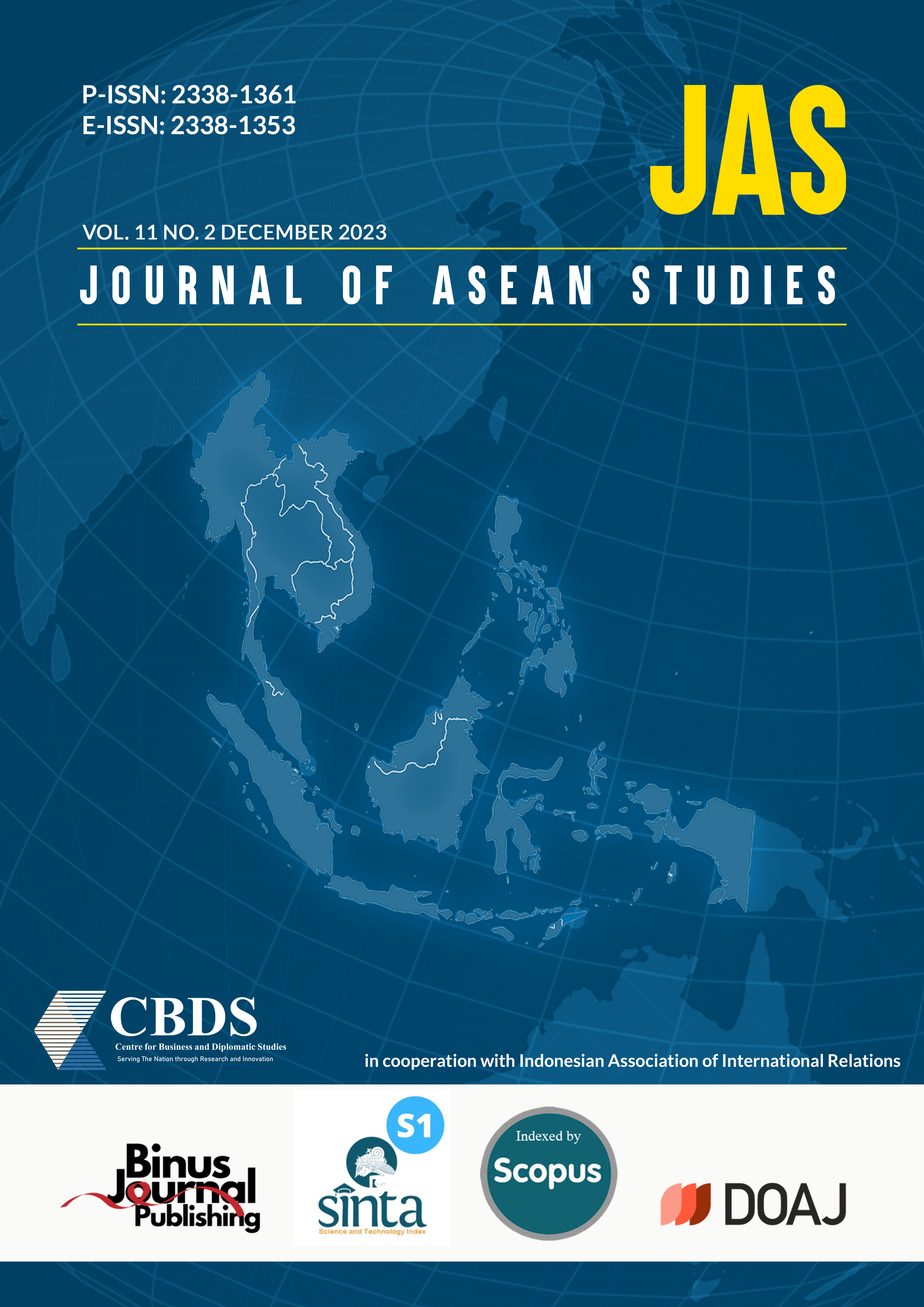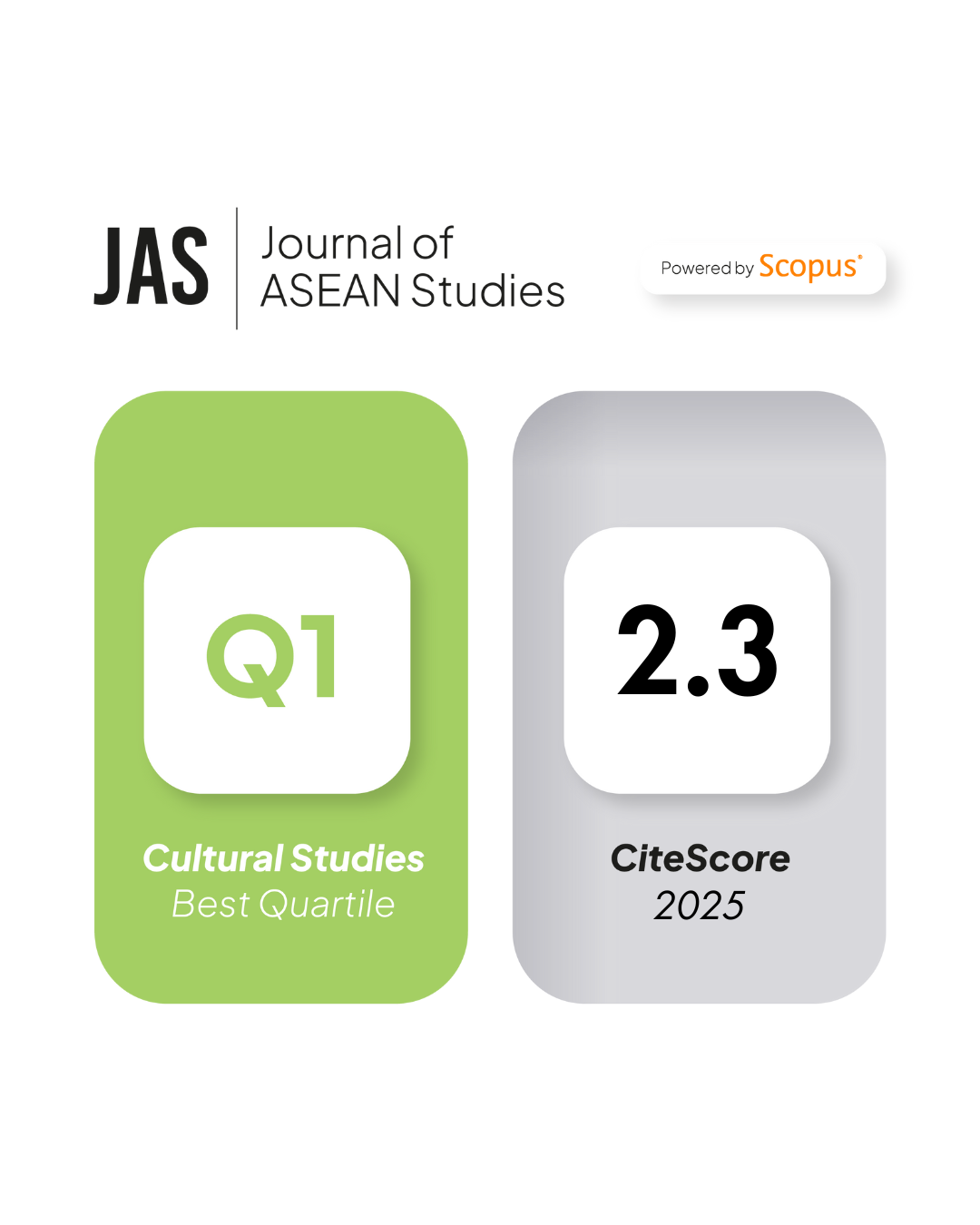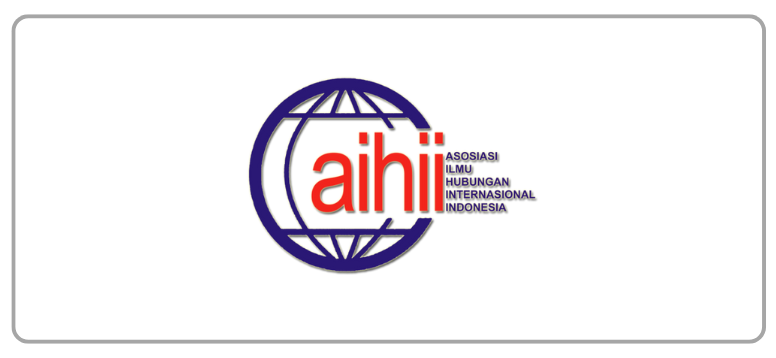Southeast Asian Regionalism: An Examination of the Progress and Priorities of ASEAN through its Joint Communiqués
DOI:
https://doi.org/10.21512/jas.v11i2.9402Keywords:
ASEAN community, joint communiqué, ASEAN priorities, regional integration, Southeast Asian geopoliticsAbstract
In pursuit of ASEAN’s objective to formalize the ASEAN Community, this article critically examines the community-building progress and the organization’s key priorities. The research is guided by two research problems. First, what are the subjects discussed in each ASEAN community pillar? Second, how are the key issues addressed in relation to each ASEAN community pillar? A thematic analysis of the joint communiqués published by ASEAN from 2004-2019 was conducted to respond to these questions. More specifically, each communiqué was tagged and analyzed, and themes were subsequently derived, enabling a comprehensive examination of each area of the ASEAN community. The article contributes significant insights into the evolving landscape of ASEAN’s cooperation and integration. The findings elucidate on the shifting dynamics and complexities that shape ASEAN’s political-security, economic, and socio-cultural communities, shedding light on the organization’s changing priorities and challenges. The ASEAN Economic Community (AEC) prioritizes key growth areas, such as tourism, Small and Medium Enterprises (SMEs), and energy. For the ASEAN political-security, its focus is on ascertaining continued peace in the region as exemplified by collaboration on non-traditional security issues. Meanwhile, the ASEAN socio-cultural community primarily centers on environmental issues, disaster response and management, and the youth. However, the advancement of the ASEAN community has faced setbacks caused by the COVID-19 pandemic and the 2021 Myanmar coup d’état. Overall, the joint communiqués manifests the different initiatives that ASEAN has taken to deepen integration and a sense of community.
References
Acharya, A. (1997). Ideas, identity, and institutionâ€building: From the ‘ASEAN way’ to the ‘Asiaâ€Pacific way'? The Pacific Review, 10(3), 319–346. https://doi.org/10.1080/09512749708719226
Al-Fadhat, F. (2022). Big business capital expansion and the shift of Indonesia’s global economic policy outlook. East Asia, 39(4), 389–406. https://doi.org/10.1007/s12140-022-09384-3
ASEAN Joint Communiqué. (2011, July 19). Joint Communiqué of the 44th ASEAN Foreign Ministers Meeting, Bali, Indonesia, 19 July 2011. https://asean.org/wp-content/uploads/images/archive/documents/44thAMM-PMC-18thARF/44thAMM-JC.pdf
ASEAN Joint Communiqué. (2013). Joint Communiqué 46th ASEAN Foreign Ministers’ Meeting Bandar Seri Begawan, Brunei Darussalam 29 – 30 June 2013. https://asean.org/wp-content/uploads/images/2013/news/joint%20communique%20of%20the%2046th%20asean%20foreign%20ministers%20meeting%2046th%20amm%20-%20final%20-%2030%20june%202013.pdf
Association of Southeast Asian Nations. (2021, February 1). ASEAN chairman’s statement on the developments in the Republic of The Union of Myanmar. https://asean.org/asean-chairmans-statement-on-the-developments-in-the-republic-of-the-union-of-myanmar-2/
Association of Southeast Asian Nations. (2008). The ASEAN charter. https://asean.org/wp-content/uploads/images/archive/publications/ASEAN-Charter.pdf
Astarita, C. (2013). Exploring Asia: Understanding the historic roots of regional contemporary challenges. Millenium, 41(3), 656–662. https://doi.org/10.1177/0305829813481004
Azis, I. J. (2018). ASEAN economic integration: Quo vadis? Journal of Southeast Asian Economics, 35(1), 2–12. https://muse.jhu.edu/article/691975
Braun, V., & Clarke, V. (2006). Using thematic Analysis in psychology. Qualitative Research in Psychology, 3(2), 77–101. https://doi.org/10.1191/1478088706qp063oa
Bryman, A. (2016). Social research methods. Oxford University Press.
Caballero-Anthony, M. (2022). The ASEAN way and the changing security environment: Navigating challenges to informality and centrality. International Politics. https://doi.org/10.1057/s41311-022-00400-0
Chairil, T., Putri, R. A. A. K., & Pertiwi, S. B. (2022). Road to ASEAN Political Security Community Vision 2025: Understanding convergence and divergence in ASEAN voting behaviors in the UNGA. Journal of ASEAN Studies, 10(2), 263–284. https://doi.org/10.21512/jas.v10i2.8175
Chen, L. L. (2020, May 13). Human rights and democracy amidst militarized COVID-19 responses in Southeast Asia. E-International Relations. https://www.e-ir.info/2020/05/13/human-rights-and-democracy-amidst-militarized-covid-19-responses-in-southeast-asia/
Chow, J. T. (2005). ASEAN counterterrorism cooperation since 9/11. Asian Survey, 45(2), 302–321. https://doi.org/10.1525/as.2005.45.2.302
Croissant, A. (2022). Comparative politics of Southeast Asia: An introduction to governments and political regimes. Springer. https://doi.org/10.1007/978-3-031-05114-2
Dalpino, C. (2021). ASEAN confronts dual crises. Comparative Connections, 21(1), 57–66.
Djalante, R., Nurhidayah, L., Van Minh, H., Phuong, N. T. N., Mahendradhata, Y., Trias, A., ... & Miller, M. A. (2020). COVID-19 and ASEAN responses: Comparative policy analysis. Progress in Disaster Science, 8, 1–12. https://doi.org/10.1016/j.pdisas.2020.100129
Dunst, C. (2021). The Myanmar coup as an ASEAN inflection point. Journal of Indo-Pacific Affairs, 4(6), 37–45. https://media.defense.gov/2021/Aug/26/2002840264/-1/-1/1/DUNST.PDF
Elliott, L. (2011). ASEAN and environmental governance: Rethinking networked regionalism in Southeast Asia. Procedia-Social and Behavioral Sciences, 14, 61–64. https://doi.org/10.1016/j.sbspro.2011.03.023
Freistein, K. (2005). ASEAN after the Bali Summit 2003: From paralysis to new life? European Journal of East Asian Studies, 4(2), 177–203. http://www.jstor.org/stable/23615357
Hew, D. (2008, January). Blueprint for an ASEAN Economic Community. East Asian Bureau of Economic Research. https://citeseerx.ist.psu.edu/document?repid=rep1&type=pdf&doi=58c95ef8a7064ba5a41bbda94c2db92c2f761bc4
Howe, B., & Bang, G. (2017). Nargis and Haiyan: The politics of natural disaster management in Myanmar and the Philippines. Asian Studies Review, 41(1), 58–78. https://doi.org/10.1080/10357823.2016.1265484
Idris., A., & Kamaruddin, N. (Eds.) (2019). ASEAN Post-50: Emerging issues and challenges. Palgrave Macmillan Singapore.
Indorf, H. H. (1975). ASEAN: Problems and perspectives. Institute of Southeast Asian.
Jones, L. (2010). ASEAN's unchanged melody? The theory and practice of ‘non-interference’ in Southeast Asia. The Pacific Review, 23(4), 479–502. https://doi.org/10.1080/09512748.2010.495996
Kapur, R. (2022). The Myanmar coup: Evolving ethnic rebel politics and civil resistance. Strategic Analysis, 46(2), 201–210. https://doi.org/10.1080/09700161.2022.2076304
Kim, M. H. (2011). Theorizing ASEAN integration. Asian Perspective, 35(3), 407–435. https://doi.org/10.1353/apr.2011.0005
Kipgen, N. (2012). Association of Southeast Asian Nations (ASEAN): Cooperation problems on human rights. Strategic Analysis, 36(1), 100–111. https://doi.org/10.1080/09700161.2012.628468
Kivimäki, T. (2001). The long peace of ASEAN. Journal of Peace Research, 38(1), 5–25. https://doi.org/10.1177/0022343301038001001
Koh, T., & Hwee, Y. L. (2020, October 16). ASEAN and EU: The untold story. Ministry of Foreign Affairs Singapore. https://www.mfa.gov.sg/Overseas-Mission/Ministry-of-Foreign-Affairs---Permanent-Mission-of-the-Republic-of-Singapore/Recent-Highlights/2020/10/ASEAN-and-EU-The-untold-story#:~:text=The%20Asean%20economic%20community%20has%20more%20than%20650%20million%20consumers.&text=The%20biggest%20difference%20between%20them,such%20as%20trade%20and%20environment
Kożuch, B., & Sienkiewicz-Małyjurek, K. (2015). Information sharing in complex systems: A case study on public safety management. Procedia-Social and Behavioral Sciences, 213, 722–727. https://doi.org/10.1016/j.sbspro.2015.11.493
Kurlantzick, J. (2022, August 29). ASEAN’s complete failure on Myanmar: A short overview. Council on Foreign Relations. https://www.cfr.org/blog/aseans-complete-failure-myanmar-short-overview
Leifer, M. (1999). The ASEAN peace process: A category mistake. The Pacific Review, 12(1), 25–38. https://doi.org/10.1080/09512749908719276
Lian, K. K., & Bhullar, L. (2011). Governance on adaptation to climate change in the ASEAN region. Carbon & Climate Law Review, 5(1), 82–90.
Mahbubani, K., & Severino, R. (2014, May 1). ASEAN: The way forward. McKinsey & Company. https://www.mckinsey.com/industries/public-sector/our-insights/asean-the-way-forward
Moorthy, R., & Benny, G. (2012). Is an “ASEAN community†achievable? Asian Survey, 52(6), 1043–1066. https://doi.org/10.1525/as.2012.52.6.1043
Morada, N. M. (2008). ASEAN at 40: Prospects for community building in Southeast Asia. Asia-Pacific Review, 15(1), 36–55. https://doi.org/10.1080/13439000802134043
Narine, S. (2008). Forty years of ASEAN: A historical review. The Pacific Review, 21(4), 411–429. https://doi.org/10.1080/09512740802294689
Nesadurai, H. E. S. (2008). The Association of Southeast Asian Nations (ASEAN). New Political Economy, 13(2), 225–239. https://doi.org/10.1080/13563460802018588
Nicolas, F. (2009, September). ASEAN energy cooperation: An increasingly dauting challenge. IFRI. https://www.ifri.org/sites/default/files/atoms/files/fnicolas.pdf
Payne, G., & Payne, J. (2004). Key concepts in social research. SAGE Publications.
Poole, A. (2015). Ambitions versus capacity: The role of institutions in ASEAN. In A. Björkdahl, N. Chaban, J. Leslie, & A. Masselot (Eds.), Importing EU norms. United Nations university series on regionalism. Springer. https://doi.org/10.1007/978-3-319-13740-7_10
Qiao-Franco, G. (2022). The ‘ASEANization’of non-ASEAN stakeholders in regional climate change cooperation. International Relations of the Asia-Pacific, 22(2), 171–203. https://doi.org/10.1093/irap/lcaa023
Rahman, S. (2018). The emergence, development, and role of ASEAN: An analysis, FWU Journal of Social Sciences, 12(1), 266–278.
Reuters. (2022, February 17). ASEAN’s five-point peace agreements on the crisis in Myanmar. https://www.reuters.com/world/asia-pacific/aseans-five-point-peace-agreement-crisis-myanmar-2022-02-17/
Rüland, J. (2021). COVID-19 and ASEAN: Strengthening state-centrism, eroding inclusiveness, testing cohesion. The International Spectator, 56(2), 72–92. https://doi.org/10.1080/03932729.2021.1893058
Ryu, Y., Minn, B., & Mon, M. M. (2021). The military coup in Myanmar: Time to prioritize ASEAN centrality and communal values. ISEAS - Yusof Ishak Institute. https://www.iseas.edu.sg/articles-commentaries/iseas-perspective/2021-27-the-military-coup-in-myanmar-time-to-prioritise-asean-centrality-and-communal-values-by-yongwook-ryu-bernard-minn-and-myat-myat-mon/
Samad, P. A., & Bakar, D. A. (1992). Malaysia-Philippines relations: the issue of Sabah. Asian Survey, 32(6), 554-567. https://doi.org/10.2307/2645160
Stubbs, R., & Mitrea, S. (2017). ASEAN at 50: The global political economy’s contribution to durability. Contemporary Politics, 23(4), 388–407. https://doi.org/10.1080/13569775.2017.1314061
Suzuki, S. (2019). Why is ASEAN not intrusive? Non-interference meets state strength. Journal of Contemporary East Asia Studies, 8(2), 157–176. https://doi.org/10.1080/24761028.2019.1681652
Tan, E. (2022). Building ASEAN identity through regional diplomacy. In From Asia-Pacific to Indo-Pacific (pp. 235–255). Palgrave Macmillan. https://doi.org/10.1007/978-981-16-7007-7_11
Trajano, J. C. (2020). Building a culture of prevention for occupational safety and health in the face of a pandemic: Lessons from the nuclear safety culture. https://www.jstor.org/stable/resrep26882
Wicaksana, I. G. W., Nauvarian, D., & Pramudia, P. S. (2023). ASEAN, COVID-19 and Myanmar crisis: Dealing with critical juncture. International Area Studies Review, 26(1), 40–54. https://doi.org/10.1177/22338659221151129
Wunderlich, J. U. (2012). The EU an actor sui generis? A comparison of EU and ASEAN actorness. JCMS: Journal of Common Market Studies, 50(4), 653–669. https://doi.org/10.1111/j.1468-5965.2011.02237.x
Yang, A. H. (2016). Strategic appraisal of Taiwan’s New People-Centered Southbound Policy: The 4Rs approach. Prospect Journal, 18, 1–34.
Yani, Y. M., & Robertua, V. (2018). Environmental studies of English School: Case study of forest fires in Indonesia and transboundary haze in Southeast Asia. Journal of ASEAN Studies, 6(1), 117–135. https://doi.org/10.21512/jas.v6i1.3964
Yukawa, T. (2018). The ASEAN way as a symbol: An analysis of discourses on the ASEAN norms. The Pacific Review, 31(3), 298–314. https://doi.org/10.1080/09512748.2017.1371211
Downloads
Published
How to Cite
Issue
Section
License
Copyright (c) 2023 Joseph Ching Velasco

This work is licensed under a Creative Commons Attribution-NonCommercial 4.0 International License.






















